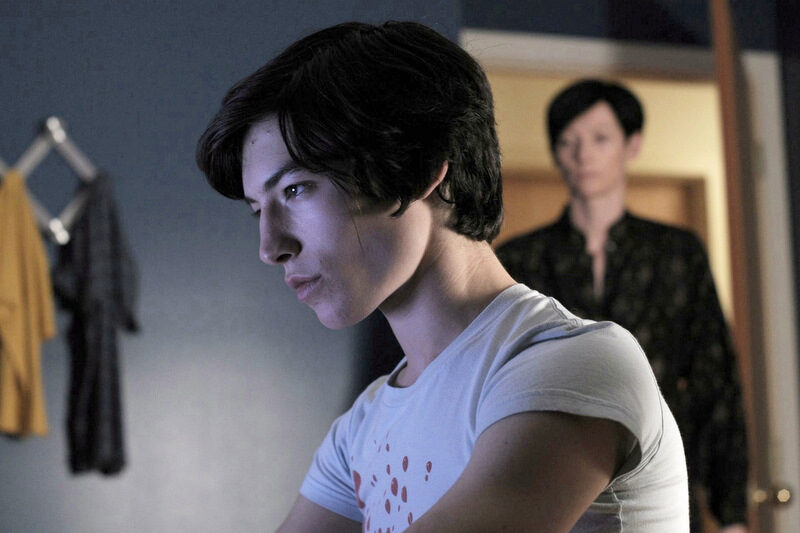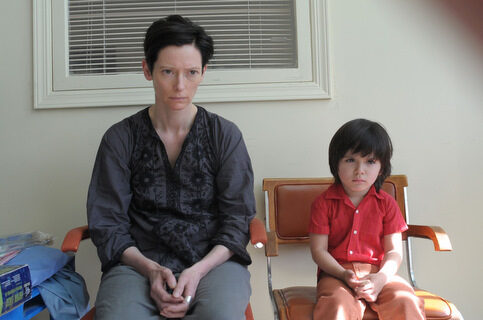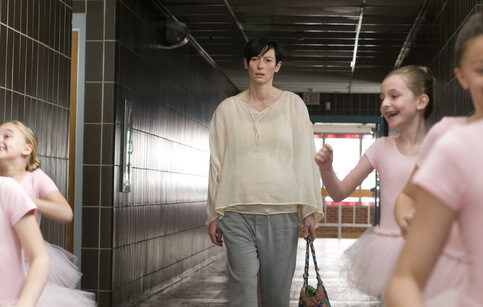Powerful Costume in We Need to Talk About Kevin | Clothes on Film
© 2011, Artificial Eye 
27 Feb ’12 Filed under Clothes from now, Girls in Films, Guys in Films. Tagged asexual, Ashley Gerasimovich, Catherine George, contemporary, cotton, ethnic, Ezra Miller, identity, indie, Jasper Newell, jersey shirt, John C. Reilly, Judy Becker, linen, Lynne Ramsay, nostalgia, pinstripe suit, red, Rock Duer, Seamus McGarvey, skinny jeans, stripes, symbolism, t-shirt, tee, Tilda Swinton, tunic top, We Need to Talk About Kevin, Windcheater. Bookmark the permalink. Post a comment. Leave a Trackback (URL).
Quite deliberately, We Need to Talk About Kevin (2011) provokes discussion. Why is Kevin evil? Was he born that way? Did his mother make him that way by withholding love? Is he a manifestation of his mother’s own hatred toward humanity? Questions one could argue that director Lynne Ramsay and screenwriter Rory Kinnear (adapted from Lionel Shriver’s novel) never intended their audience to be able to answer satisfactorily.
To describe the film as ‘arty’ would be doing everyone involved a disservice, but there is no getting away from its obvious stylisation. Cinematographer Seamus McGarvey, production designer Judy Becker and costume designer Catherine George deserve credit for combing their talents to form a cohesive palette which incorporates flashes, splashes and swathes of deep red. Incidentally, Lynne Ramsay is an admirer of director Nicolas Roeg, who of course applied red to striking effect in costume for Don’t Look Now (1973). Less subtext and more just text, using this colour within the narrative of We Need to Talk About Kevin connotes the foreshadowing and aftermath of death. The opening scene presents Eva (Tilda Swinton) as a Christ like figure bathed in the blood red fruit juice during Spain’s La Tomatina festival. Minutes later we witness her and Franklin (John C. Reilly) conceiving what eventually appears to be the spawn of the devil.

Tilda Swinton as Eva and Rock Duer as young Kevin. The colour red is hugely symbolic in We Need to Talk About Kevin, but used relatively sparingly with Catherine George’s costume design.
Red is also apparent in Kevin’s clothes as a toddler (here played by Rock Duer), in a short sleeve shirt with light stripes; as a boy (Jasper Newell) in a crew neck t-shirt and as a teenager (Ezra Miller), wearing a particularly vivid red windcheater. Narrow stripes connect all three incarnations of Kevin. Stripes are excellent at providing consistency while at the same time implying individuality. Plus they force perspective, making us read something in a specific way. All of Catherine George’s costumes have an overriding sense of retro. At any even moment it can be difficult to decipher in which decade the film is set and where. They provide a melancholy that soften the tone of a cruel story that really provides no respite of its own.
There is comfort in nostalgia, even for Eva washing and ironing the t-shirts of her psychopathic imprisoned son, possibly for his return to her home after release. Clothes provide a tangible connection between Kevin and his mother. Even though memories of his growing up recall pain and, worse still, apathy, Eva still cherishes them as her only semblance of normality. Eva also wears her husband Franklin’s Led Zeppelin t-shirt, its large size forming a blanket around her as she sniffs the fabric for any reminiscence she can tap. Clothes are more important than photographs. Photographs can lie but clothes evoke a nostalgia we alone create. For Eva, Kevin and Franklyn’s clothes – note not those of her daughter Celia (Ashley Gerasimovich) – are all she has left.

Clothes for teenage Kevin are tight, implying his lean physique, while clothes for his mother Eva are generally loose and soft, linens and cottons, implying her vulnerability. This demonstrates how two actors of a similar build can be characterised in a completely opposite way by what they are wearing.
As a teenager, Kevin’s clothes are indie inspired. His jeans are skinny, his satirical t-shirts at least a size too small, his footwear plain white trainers. All attention is drawn to Kevin’s lithe and powerful body. He is knowingly provocative, ensuring those around him, especially Eva, feel uncomfortable. By contrast Eva’s clothes are often baggy and swallow her equally slender frame (she and Kevin are similar in physical build). Ethnic overtones remain from her past as a travel writer in tunic tops tied at the neck with drawstrings. These are even seen later in the chronology of the story, teamed awkwardly with a grey pinstripe suit. Fitted jeans and tiny tees make Kevin appear formidable, whereas loose clothes make Eva appear weak. He wears his clothes, she hides in hers.
Despite We Need to Talk About Kevin never feeling subtle, particularly in regards to its unambiguous red aesthetic, in terms of costume the overall look is perfect. We can decipher character subtly or as in all the most effective costume design, ignore it entirely. Costume compliments the visual expression Lynne Ramsey has chosen to adopt. Kevin is a monster but does he ever dress like one? No. He is handsome, odd and just different enough to be normal. He could be living next door.
We Need to Talk About Kevin is released on Blu-ray and DVD on 27th February.
© 2012, Chris Laverty.
Related Posts: